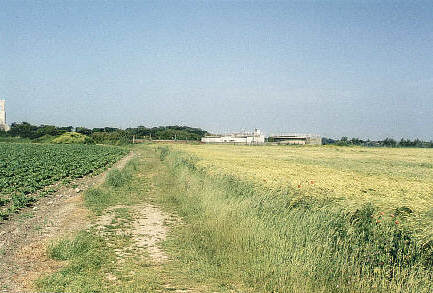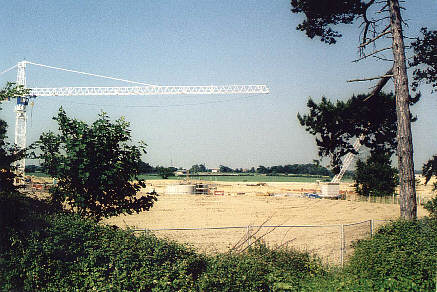|
|
CORTON - a birding guide
by Ricky Fairhead

Since 1994 ornithological attention has slowly changed from the traditional area of the town parks in Lowestoft, to the more northerly parish of Corton. The latter being considerably easier to work, and it also suffers from far less disturbance than any area to the south The photo to the left shows the view looking south along the dusused railway line from Stirrups Lane.
Most of the attention has centred on the disused railway line south of Stirrups Lane (1) [see map below], which is conveniently situated just east of the main A12 trunk road. . In the six years that this site has been watched it has produced a remarkable array of both county and national rarities. The second Arctic Warbler Phylloscopus borealis was found here, along with numerous other warblers including Icterine Hippolais icterina, Barred Sylvia nisoria, Wood P. sibilatrix, Pallas's P. proregulus and Yellow-browed P. inornatus. In addition Suffolk's fourth and fifth records of Dusky Warbler P. fuscatus occurred here, along with the third county record of Rustic Bunting Emberiza rustica. Other species seen on the railway line include Rough-legged Buzzard Buteo lagopus, Long-eared Owl Asio otus, Lesser Spotted Woodpecker Dendrocopos minor, Ring Ouzel Turdus torquatus and Red-breasted Flycatcher Ficedula parva. Given its excellent east coast position just abut anything is possible. Roadside parking is very limited, and the most convenient site for parking is at nearby Corton church, when not in use for church services of course. It is envisaged that the new sewage works under construction immediately west of this railway line will have its own public car park which should make things much easier.

View from the coast of the old sewage works at Corton.
The open filter beds of the existing Corton sewage works (2) are often worth a visit, these being good for both Grey Motacilla cinerea and White Wagtails M. alba alba. The adjacent fields often hold Grey Partridge Perdix perdix and migrating Chats. A Long-eared Owl was seen in the hedgerow here in April 2000.
The hedges to the north of Corton sewage works have in the past held a Red-backed Shrike Lanius collurio, whilst the adjacent football field and mini golf course have great potential. As of late autumn 2000 the Broadland Sands Caravan Park is being extended southwards, so the hedgerow hear may not be such a draw for migrants for much longer. All these area can be accessed from the coastal footpath running along the constanly eroding cliff edge. There is also a footpath which runs north along the inland fence of the sewage works, which then passes through the hedge and continues through the caravan park inland of the football field and golf course This path then turns westwards back to join the coast road. The sea itself can prove rewarding as there are often small groups of duck of various species resting on the sea itself, and Manx Puffinus puffinus and Sooty Shearwaters P. griseus have been seen quite close inshore here. One winter a Little Auk Alle alle was watched coming in from the sea with a flock of Starlings Sturnus vulgaris, and as the flock reached the cliff edge and headed inland the auk to its credit realized something was not quite right and peeled off and headed back due east out to sea until lost to sight.

The clifftop footpath looking north towards Hopton and Gorleston.
Further to the north is the disused M.o.D. radar station complex (3), which is now a private residence known appropriately as Radar Lodge. Do not block the gateway as it is in constant use. The owner does not minder birders walking along the access road to view the fields, but the actual compound itself is of course private. The grass is rather long in most place but there are some patches of short turf, and even those birds which are hidden in the grass regularly fly up to perch on the fence wires. The local Grey Partridges often get in here, as well as the adjacent fields. This area has in the past attracted a pair of Red-backed Shrikes, as well as more recently, Twite Carduelis flavirostris and Shore Larks Eremophila alpestris. The parish boundary between and Corton and Hopton runs along the access road to this site and its northern fence line.
The fields to the west of the disused M.o.D. site attracted fame back in October 1995 when they held Suffolk's first ever Pine Bunting E. leucocephalos. A fine male which though only present for one day, more than made up for the male Pine Bunting x Yellowhammer E. citrinella hybrid seen at Sizewell in 1982. The mixed finch and bunting flock often present here is always worth a look as Lapland Buntings Calcarius lapponicus and Shore Larks have been seen here. In autumn 1999 a juvenile Peregrine Falco peregrinus was noted sitting in the middle of the ploughed field here, after a few minutes in took off, gained height and headed south east out to sea.
Towards the western edges of the parish, in the fields by the A12 a Collared Pratincole Glareola pratincola was watched hawking insects for 10 minutes near Rackham's Corner on 29th September 1997, another good record for the area.
The stretch of the disused railway line west of the M.o.D site is very overgrown, and difficult to access from the footpath that crosses it, although it undoubtedly attracts a number of unseen rarities. The above mentioned Pine Bunting in 1995 was seen in these hedges as well, and a year later a Barred Warbler gave quite good views along this hedgerow.
A number of dramatic changes are in the process of being made to the above area. A large Waste Water Treatment Centre (Sewage Works to most people) (4) is currently being constructed on the site of the former Potters Holiday Village adjacent to the disused railway line south of Stirrups Lane. This site which had been derelict and overgrown for several years was an excellent place for migrants. When construction is completed, scheduled for spring 2001, the existing filter beds will be demolished. Just what effect the new treatment works will have on migration in the area is open to speculation; although the extra lighting (and extra flies with a bit of luck) will hopefully improve things.

The new sewage works under construction.
The year 2000 has started well for Corton with the appearance of an Alpine Accentor Prunella collaris around the sewage works and church area on 13th May 2000. (see videograb below).
During autumn 2000 the field between the MoD site and the
coast road has already attracted a juvenile Dotterel Charadrius
morinellus, and two firsts for the Lowestoft area. They were Buff-breasted
Sandpiper Tryngites subruficollis, and Caspian Gull
Larus cachinnans. Hopefully during the years to come many more good
birds will be found in the parish.

 Alpine
Accentor, Corton, 13th May 2000.
Alpine
Accentor, Corton, 13th May 2000.
Updated: February 2001